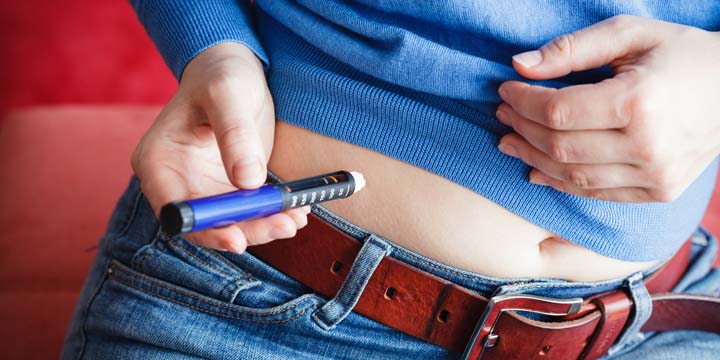
Are you wondering what those lumps are where you inject your insulin? Is your blood sugar high one day and low the next, despite eating the same thing and nothing else really changing? Does it seem like your insulin isn’t working? If these questions sound familiar, you may have something called lipohypertrophy or a “lipo.” Lipos are areas of fatty tissue and scar tissue that develop under the skin.
Lipos are more common in individuals who take insulin versus other types of injections (e.g. Ozempic®, Mounjaro®, etc.). This is due to insulin being a growth factor, which can lead to an increase in fat cells at the injection site.
What increases the risk of a lipo?
Reusing needles and not rotating injection sites (giving insulin in the same small area repeatedly) are the 2 most common risk factors. Other factors include the number of insulin injections per day you are using, the amount of insulin administered in 1 injection and how many years you have been using insulin.
How do lipos affect blood sugar control?
Lipos can increase blood sugar and A1C. When injecting into a lipo, insulin absorption can vary: it may not absorb as well or absorption may be delayed. This variability in absorption can lead to both hyperglycemia (high blood sugar) and hypoglycemia (low blood sugar) as the action of insulin is not matching the rise in blood sugar.
When insulin absorption is reduced, insulin needs will increase to bring blood sugar to target. The cost of insulin also increases due to higher insulin doses. When another ‘non-lipo’ site is selected using this higher dose, insulin will be absorbed properly, increasing the risk of hypoglycemia. Regulating insulin doses that have unpredictable absorption can be very challenging.
For those living with type 1 diabetes, lipos can increase the risk of diabetic ketoacidosis.
How do you know if you have a lipo?
Red flags that you may have a lipo include not thinking about where you inject your insulin, having a favourite area to inject insulin as it hurts less, or having unexplained hypoglycemia (low blood sugar that is not caused by delayed or missed meals, exercise or taking too much insulin/medication). It is best to assess for lipos in a well-lit area while either laying down or standing (standing in a shower works well).
Start by spreading lotion or gel over the area where you give your insulin. This allows your fingers to gently move over the area and makes it easier to feel the lumps. Using your fingertips, slowly move in a circular motion. Lipos can be bigger (fist-size) or smaller (pea-size) and the skin may feel thick, dense or rubbery. Some lipos may be visible to the naked eye; however, many can only be felt and some may only be detected by ultrasound.
If you think you have a lipo, talk to your diabetes healthcare team before switching injection sites. When moving your insulin injection from an area with a lipo to an area with no lipo, the risk of hypoglycemia is high. It is important to reduce your dose of insulin when moving sites and to increase your blood sugar testing initially, for added safety.
Speak with your healthcare team about how to assess for lipos and how to adjust your insulin dose for injecting in a different site.
Preventing lipos
Lipos can take 3 to 6 months to get rid of, or reduce in size, so prevention is important. Here are some tips to prevent lipos:
- Use a new 4-mm needle for every injection. Reusing needles, even once, can dull the needle tip leading to skin damage and scar tissue.
- Rotate injection sites and give injections at least 1 finger-width (1 to 2 cm) apart. If you are giving insulin in your abdomen, rotate around the whole abdomen. For example, split your abdomen into 4 quadrants using your belly button as the centre. Visualize a small clock in each section and slowly move your injections around the circle. Avoid your belly button area (at least 5 cm away – further away is fine just not closer), scars and stretch marks.
- If you are on 2 types of insulin, consider giving your long-acting insulin in the outer thigh or upper buttock. Standing in front of a mirror can help to see your injection site better.
- If you are using an insulin pump, ensure that you rotate the pump site every 2 to 3 days.
- If you take more than 60 to 80 units of insulin in 1 dose, ask your healthcare team if you are eligible to use a concentrated insulin (the same dose given in a smaller volume) as this may be helpful to reduce the number of injections needed.
- Inspect your injection sites often.
The Forum for Injection Technique has some great resources on best practices for injection, including information about injection site rotation.
Being aware of proper injection technique and avoiding lipos can improve your A1C, cause less blood sugar variability and help reduce unexplained hypoglycemia.


